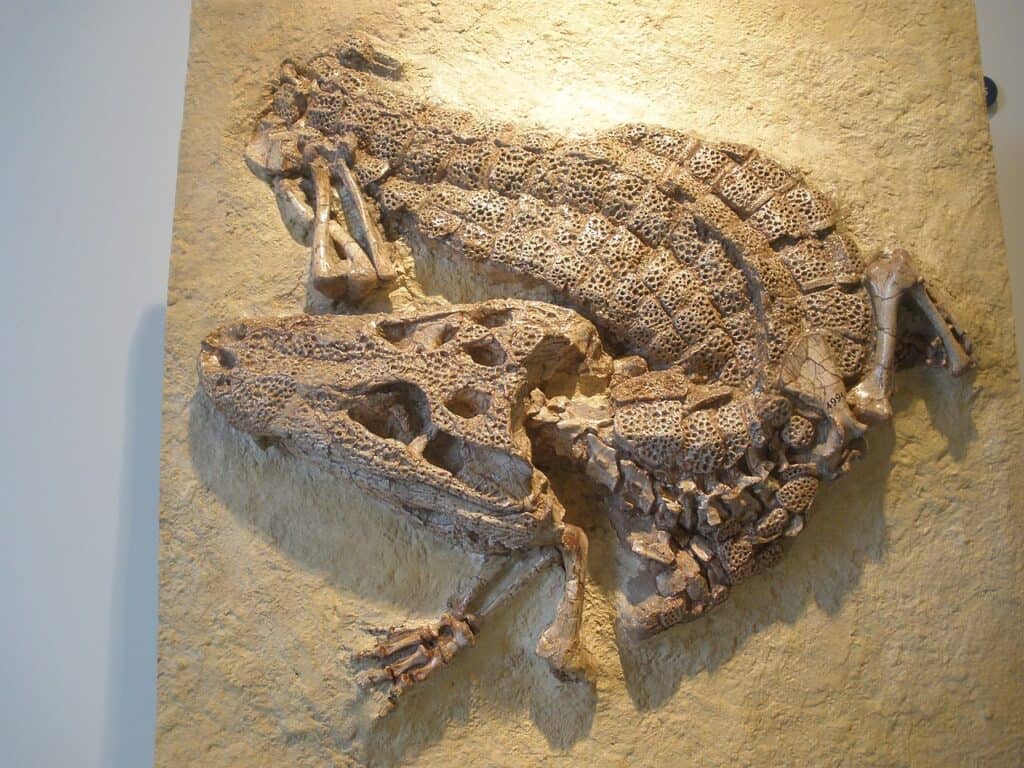Alligators are ancient creatures with a history that stretches back millions of years. True members of this genus evolved after the dinosaurs walked the earth, but their ancestors lived alongside them. Today, we know them for living in the swampy coastal areas of the southeastern United States. However, they’ve inhabited other parts of North America as fossil records show. That might make you wonder, what’s the oldest alligator fossil ever found?
We’ll show you everything you need to know about the oldest alligator fossils including their age, where they came from, and what they taught modern scientists.
To be clear, our examination of this topic is focused on the true Alligator genus. We’re going to talk about when this genus came into being and not focus on when all their ancestors emerged. That way, we can avoid muddying the waters about what constitutes the oldest alligator fossils.
What Is an Alligator?

Alligators are powerful, semi-aquatic creatures.
©iStock.com/Cindy Larson
Modern alligators are crocodilian reptiles that are known for being long, powerful, and potentially deadly. They are semiaquatic creatures that often hide beneath the waterline and ambush their prey from the cover or water.
The genus Alligator only contains seven species, and five of them are extinct. The two remaining species are known as the Chinese alligator and the American alligator.
The Chinese alligator (Alligator sinensis) is restricted in both its size as well as its range. The creature measures about 7 feet long and weighs between 80 and 100 pounds at the higher end of its potential size. They are only found in the Anhui province of China, and they’re one of the smallest crocodilians.
The other species, the American alligator (Alligator mississippiensis), is much larger. They’re long crocodilians that measure anywhere from 400 to 800 pounds and grow between 8 and 12 feet long. They are found on the eastern and southern coasts of the United States, from North Carolina to Texas. This species has also been found as far south as Tamaulipas, a state in northeastern Mexico.
Although both species are carnivores, the American alligator is an ambush predator and the Chinese alligator is more of an opportunist. Today, the Chinese alligator is rare, but the American alligator is thought to number in the millions. They frequently appear in areas that are inhabited by humans, including rural and suburban homes, golf courses, public swimming pools, and more.
When Did Alligators First Appear?
The ancestors of alligators evolved over 240 million years ago. Roughly 80 million years ago, the very first crocodilians appeared in a time that is known as the Cretaceous period. However, the first true alligator species that has been identified is called the Alligator prenasalis, and it’s believed that they appeared 65 million years ago.
These fossils of the extinct alligator species are found throughout a wide range. Many of the most productive dig sites are located in modern-day North Dakota, South Dakota, British Columbia, and others. Alligators were once far more widespread than they are today.
However, true alligators from the alligator genus probably never walked the planet alongside other creatures.
How Old Was the Oldest Alligator Fossil Ever Found?

Oldest fossil over alligator ever found was about 37 to 34 million years old.
©Ghedoghedo / public domain – License
The oldest alligator fossil ever found was about 37 to 34 million years old, and it formed during the waning days of the Eocene Epoch. The fossils are attributed to the Alligator prenasalis, the creature believed to be the first true member of the Alligator genus.
The fossils were found in the Chadron Formation in northwestern Nebraska, and the 2015 discovery was the oldest fossils of this creature ever found. The discovery comes without a hard and fast date attached to it, but the Chadron Formation was created between 37 and 34 million years ago, making this an appropriate age for the alligator fossils.
The Chadron Formation spreads across parts of North Dakota, South Dakota, and Nebraska. In these areas, fossils of the Alligator prenasalis species and others have been found.
The Other Alligator Species
We’ve identified three of the seven species of alligators. The American and Chinese alligators are the extant species, and Alligator prenasalis are believed to be the oldest member of the genus Alligator. So, let’s take some time to identify all the species.
- Alligator prenasalis
- Alligator mcgrewi
- Alligator olseni
- Alligator sinensis
- Alligator thomson
- Alligator mefferd
- Alligator mississippiensis
The largest remaining species is the American alligator.
The Oldest American Alligator Fossils
Scientists have found evidence of the American alligator in fossils dating back as far as the Pleistocene epoch, which started 2.5 million years ago and ended 11.7 thousand years ago. These fossils are from the same species, suggesting that the species has survived in America for a long time.
Interestingly, scientists in 2016 discovered a fossilized skull that was between 5.3 and 23 million years old. This skull was incredibly similar to the American alligator. The researchers concluded that this species had lived in North America without changing very much for at least the last 7 to 8 million years.
Not only was such a discovery surprising, but it also indicates that the American alligator hasn’t evolved much in millions of years.
What Did the Oldest Alligator Fossil Teach Us?
The oldest alligator fossil was incredibly educational for the people who made the discovery. Interestingly, Alligator prenasalis was originally classified as a type of crocodile rather than an alligator. However, the recovery of a more complete skeletal fossil led to reclassification in 1918.
The discovery was very useful in helping scientists determine when true alligators emerged as a genus. Moreover, this discovery reinforced the distinctions between crocodiles and alligators in the scientific community.
The oldest alligator fossil doesn’t have a distinct date attached to it. However, the oldest one that has been discovered so far came from a rock formation that happened between 37 and 34 million years ago. Even older alligator fossils could potentially be found, especially because the oldest ones were located in 2015.
Up Next:
- What Is the Oldest Whale Fossil Ever Found?
- Largest Ever “Dragon of Death” Fossil Discovered
- 14 Dinosaurs that Lived in Texas (And Where to See Fossils Today)
- WOW! Learn About the Largest Snake Fossil Ever Found
- Meet The Holy Grail of Ice Age Fossils: The La Brea Tar Pits
The photo featured at the top of this post is © Willyam Bradberry/Shutterstock.com
Sources
- BioOne (1970) bioone.org/journals/journal-of-herpetology/volume-49/issue-4/14-069/First-Fossil-Alligator-from-the-Late-Eocene-of-Nebraska-and/10.1670/14-069.short
- Florida Museum of Natural History (1970) floridamuseum.ufl.edu/florida-vertebrate-fossils/species/alligator-mississippiensis/
- BioOne (1970) bioone.org/journals/journal-of-herpetology/volume-50/issue-2/15-023/Cranial-Polymorphism-and-Systematics-of-Miocene-and-Living-Alligator-in/10.1670/15-023.short
Thank you for reading! Have some feedback for us? Contact the AZ Animals editorial team.






